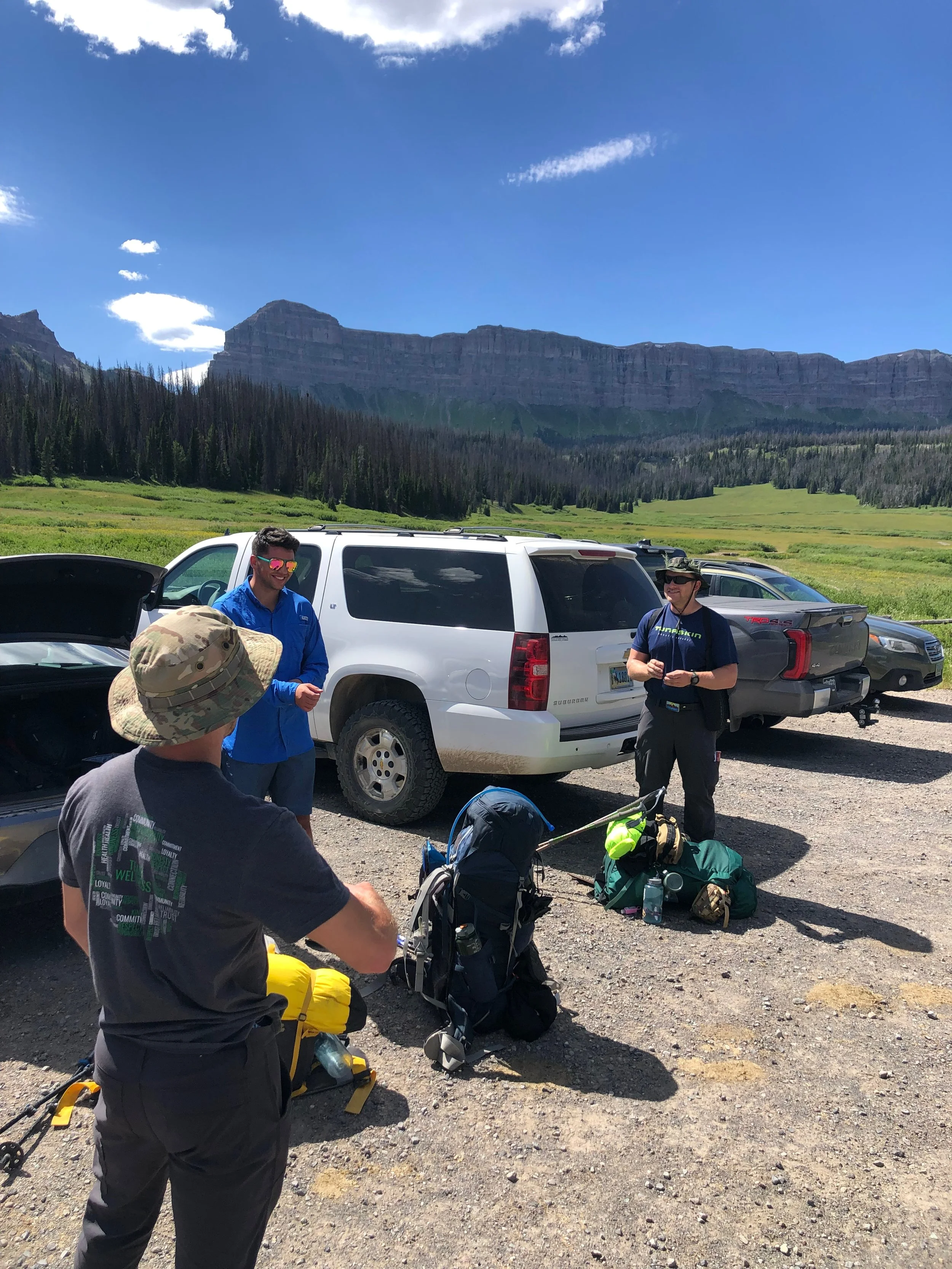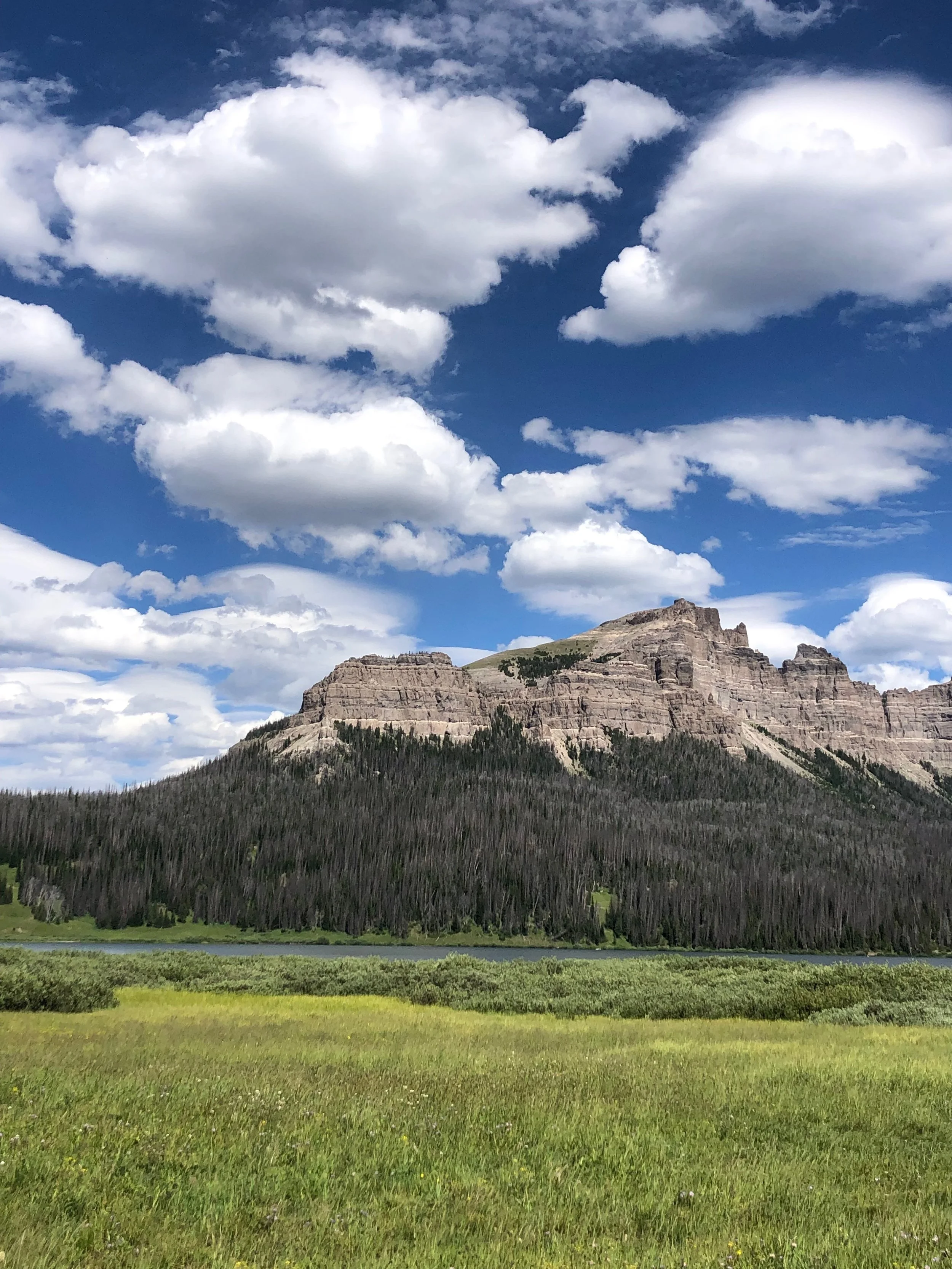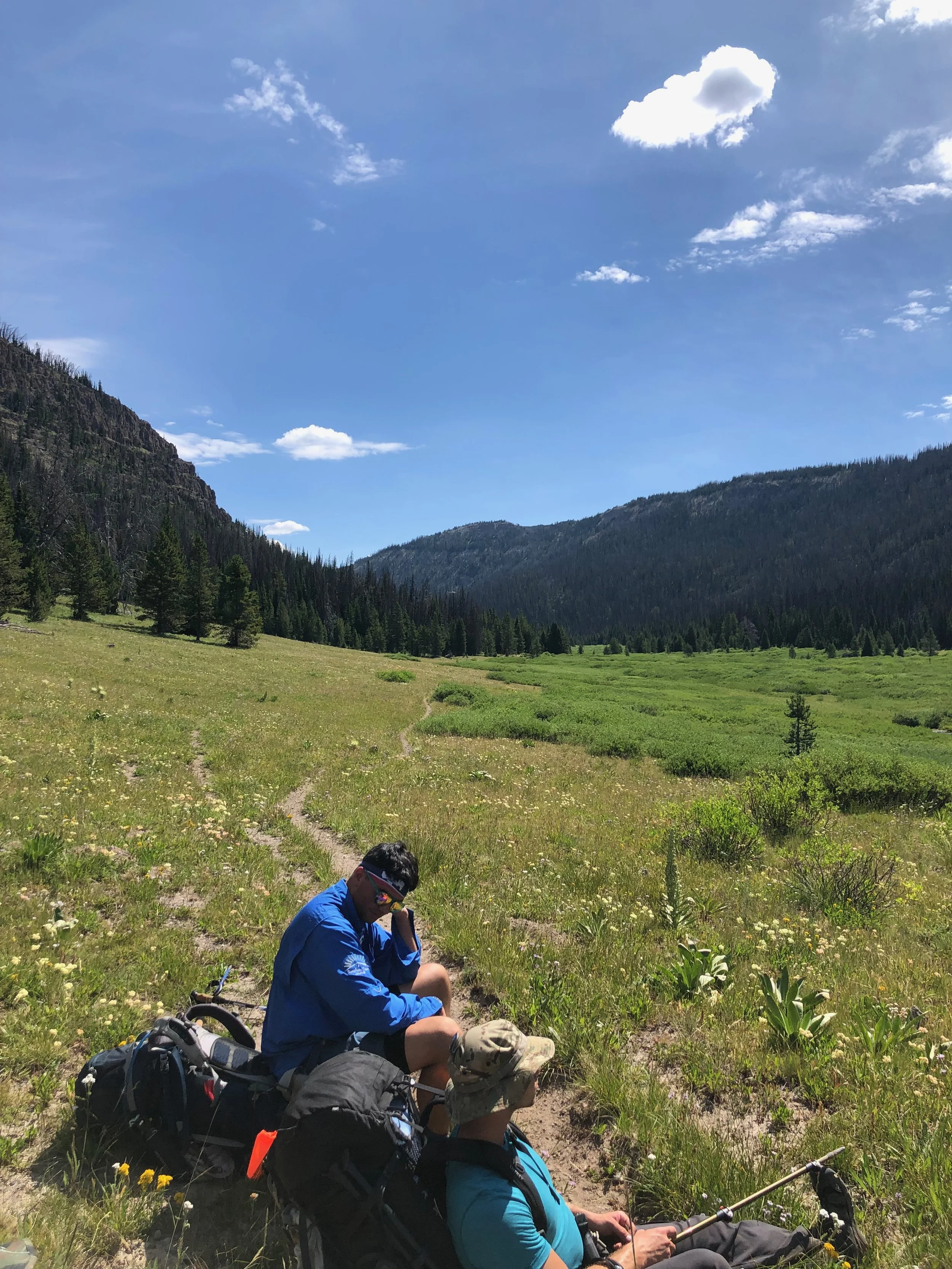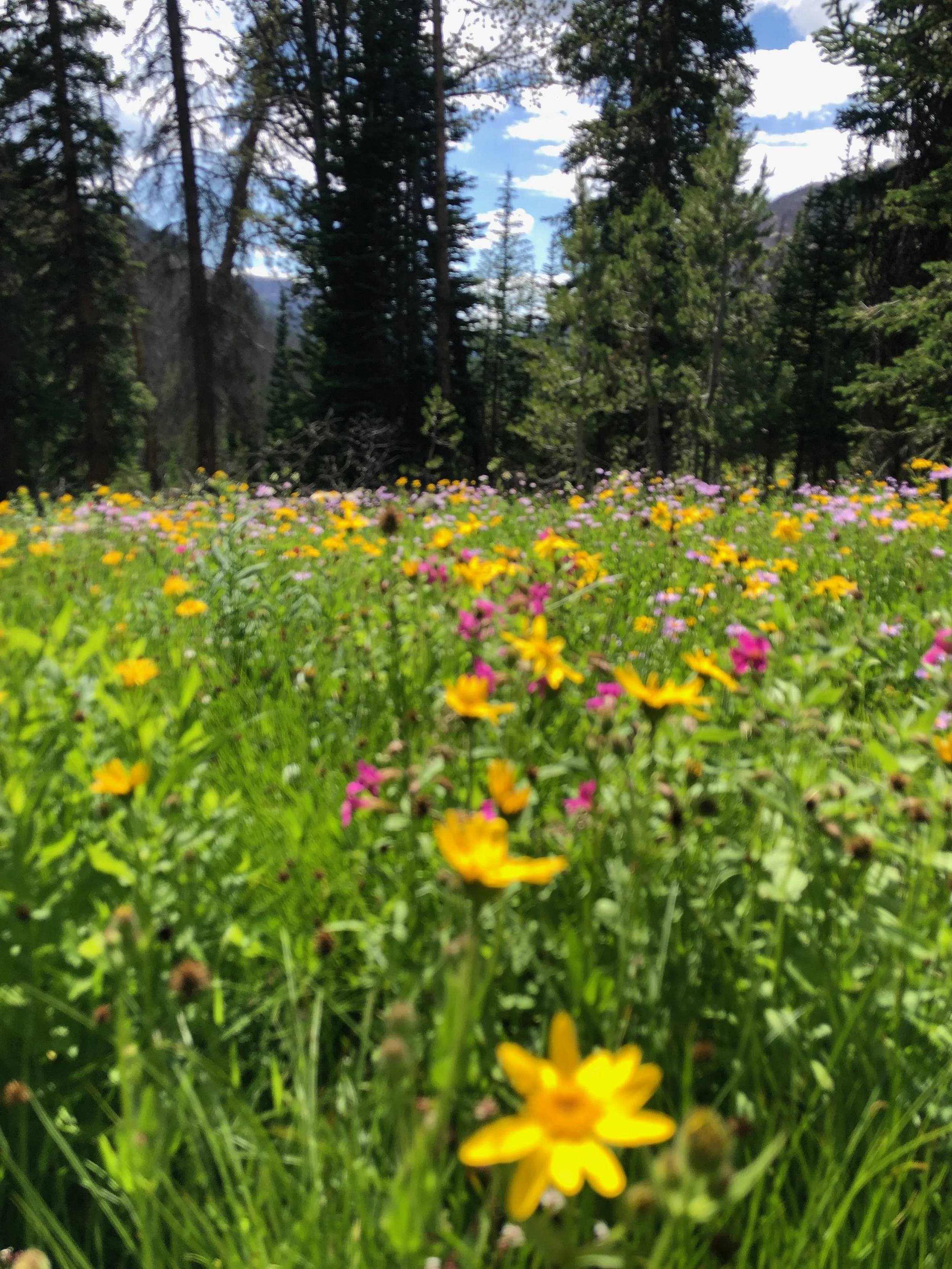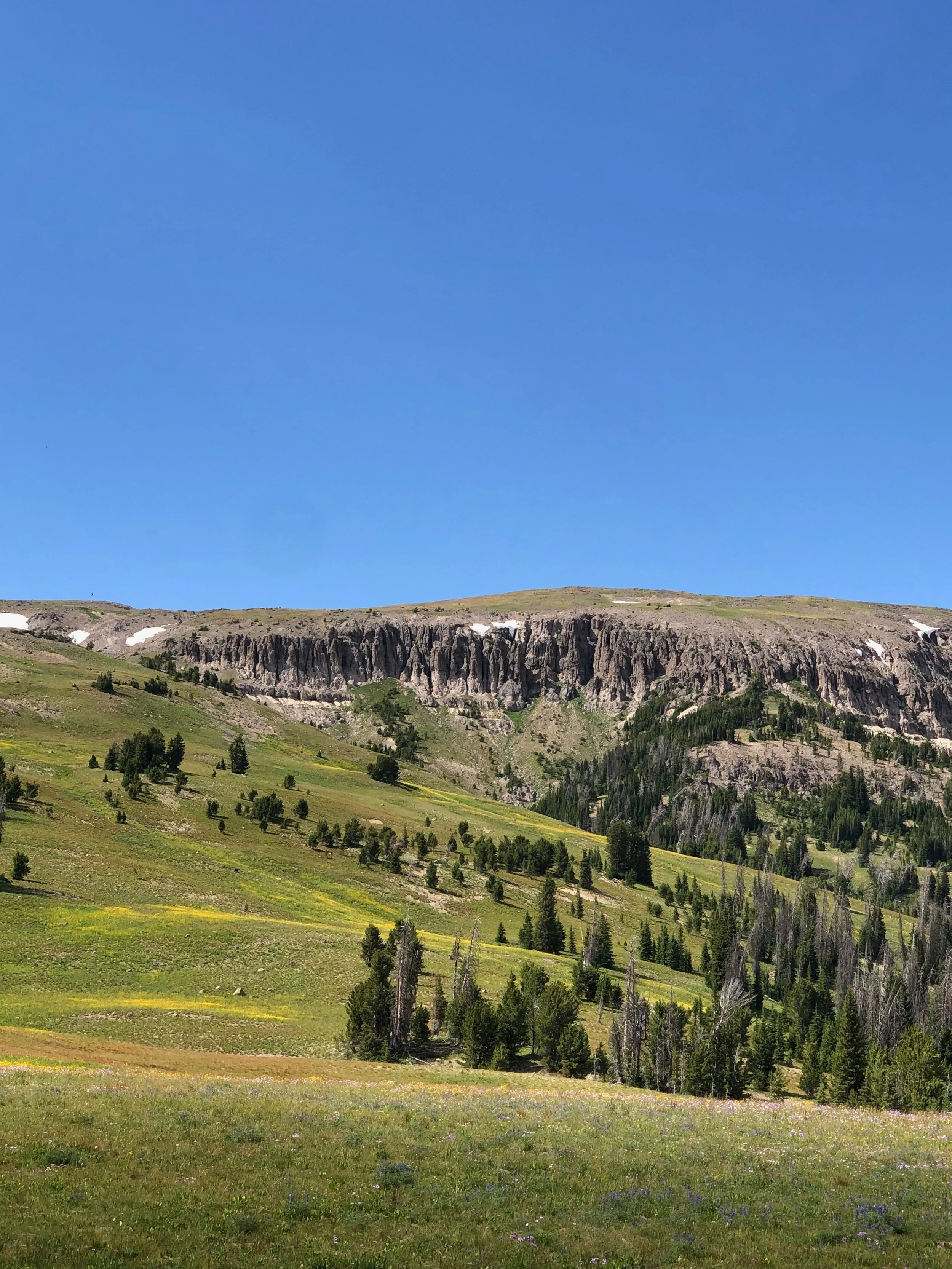Tetons Wilderness
July 27, 2023
60 miles over 6 days, crossing rivers and plateaus, dodging thunderstorms, and encountering animals in some of the most remote and untouched wilderness I have ever seen.
Day 1 – Camp at Cub Creek
After driving 12 hours from Portland, we picked up my roommate’s hometown friends from the Gros Venture Campsite outside Jackson Airport. We drove another hour to the trailhead near Brooks Lake and Lodge. Arriving around 11 am, we ate our sandwiches and loaded the bags. Because it was such a long adventure, my bag weighed more than normal, nearly 55 lbs.
The first day was an easy 7-mile hike. Passing Brooks Lake and Rainbow Lake, we watched the sheer mountains and cliff faces cast a dramatic landscape. As we hiked into the valley, we felt going downhill was nice, but we could see the inevitable uphill foreshadowing our pain for the last day. After making it to the bottom of the valley, we took off our shoes and crossed Cub Creek. Approaching our 7-mile mark, we looked for camp and found an established outfitter’s camp. We unknowingly pitched our tents in a grazing pasture. After I washed off in the river, we had a fire, ate dinner, and all chatted about the day. I dined on a Lasagna Mountain House Meal, saving the more favorable options for harder days. Everyone was pretty tired and knew tomorrow would be harder, so we decided to turn in as the sun set around 9 pm.
The sound of an animal breathing heavily near my tent startled me awake. Being in bear country, I grabbed my bear spray and unlocked the safety. I lay still and woke up my friend. Imagining what it could be, we both listened carefully and quietly. After the animal dispersed, we investigated and took one last bathroom break. I kept the bear spray close by while I slept.
Day 2 – Perry N. Boday Lake
Around 8 am, we woke up and searched the camp for more clues regarding our late-night visitor. Looking at the tracks, I realized the questionable bear was actually a split-toe, most likely an elk or moose. I felt better, but still had serious doubts about backpacking in grizzly country. After the investigation, we ate breakfast, had a little fire to warm up, and packed up.
For breakfast, I combined granola, freeze-dried berries, collagen (contains about 20g of protein and helps my joints on the trail), and water in a pre-made ziploc bag – cheap, easy, and delicious!
We started hiking around 9 am, a late start for a 14-mile day. The goal was to hike through the valley, up a mountain pass, and go another 5 miles to a high alpine lake where we would camp. The hiking wasn’t terrible, but the heat made it less enjoyable. We hiked about 7 miles through beautiful, open pastures and found a spot near the river to have lunch and replenish water. Around 1 pm, we noticed an afternoon thunderstorm gathering. The clouds grew dark and were heading straight for us. Quickly, we set up a tarp and ate lunch as the rain came down. After about an hour, the storm cleared and we continued our hike.
After climbing the mountain pass, we were exhausted. The wildflowers, however, were gorgeous and became more abundant the higher we went. When we reached the top of the pass, we saw the entire mountain range and the Continental Divide. We saw the incredible plateaus we would call home for the next few days. On a distant plateau, we saw our first grizzly bear, grazing a comfortable 300 yds away from us.
After looking at the map, we realized we had another 7 miles to our campsite. All exhausted, we pivoted and hiked 2 miles to a closer lake, Perry N. Body Lake. The lake was breathtaking, but the bugs were overwhelming. So tired, we didn’t care, we set up camp on a ledge overlooking the lake. We washed off in the lake and collected water. More storms came while we were trying to eat, and staying dry under the tarp was difficult with the wind. Relaxing was also difficult with the hordes of mosquitoes and frequent storms, so everyone went to bed relatively early again. As I closed my eyes, I heard elk calling out to each other in a nearby valley.
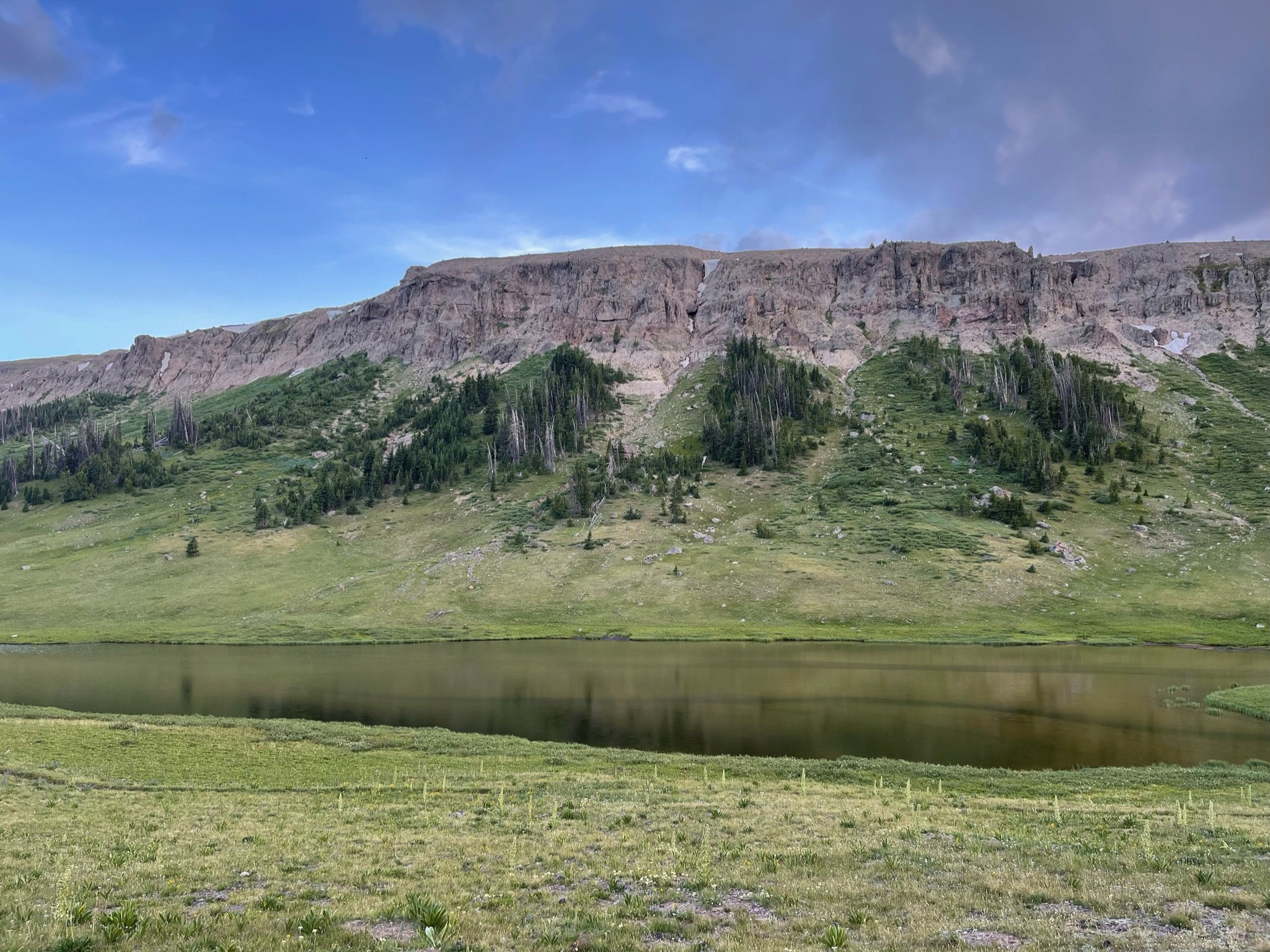
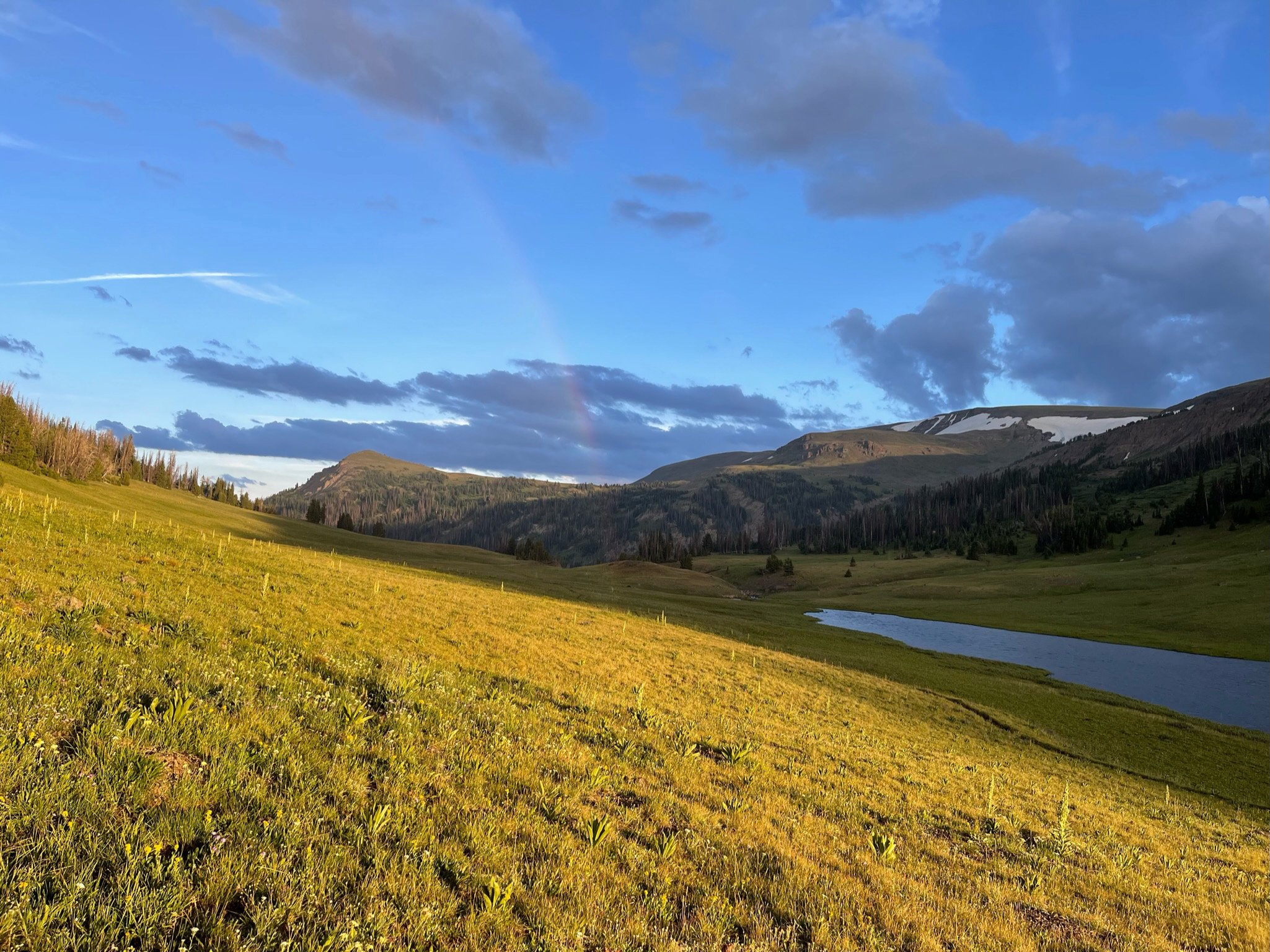
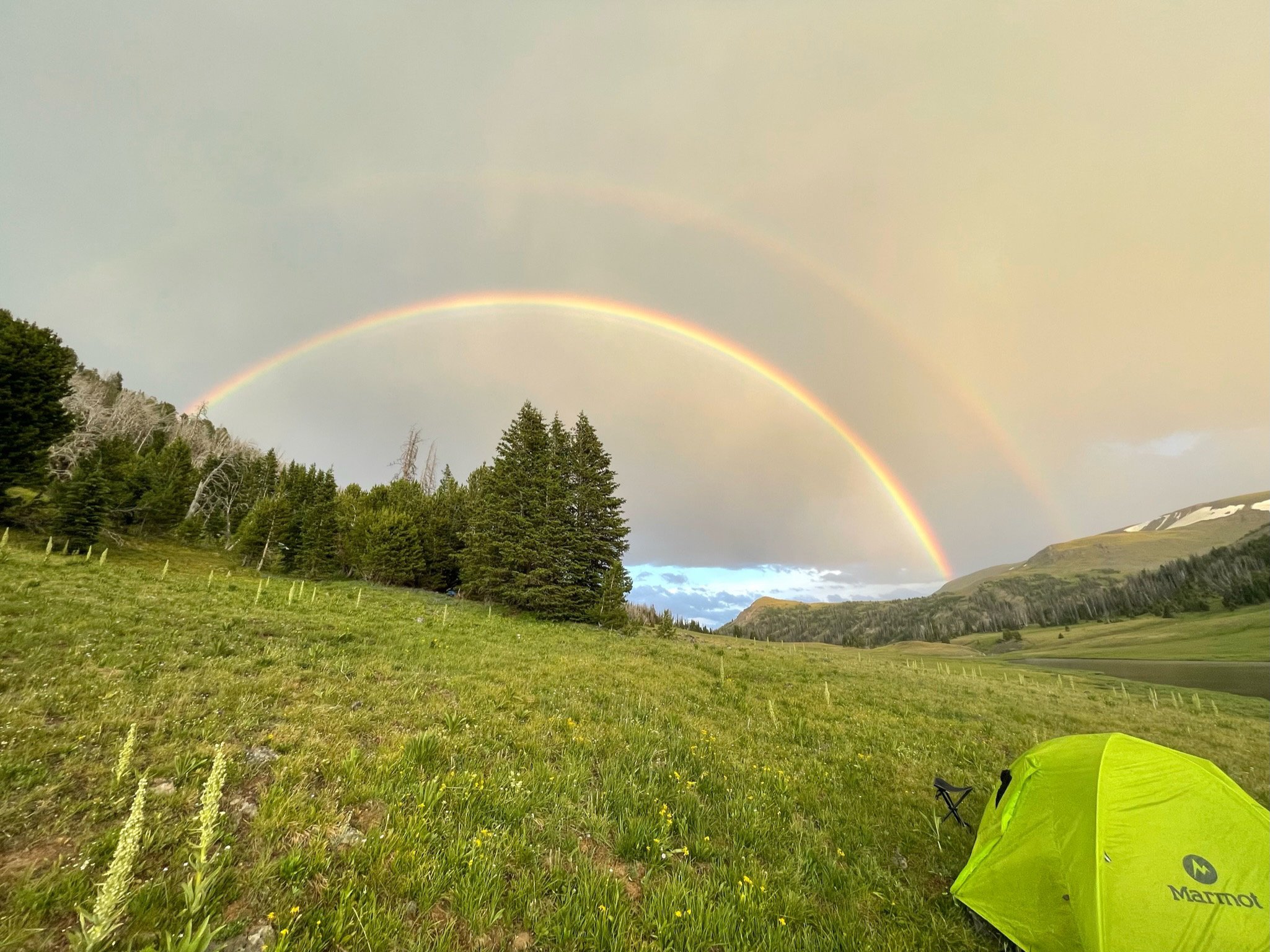
Day 3 – Cliff Side Shelter
We woke up around 8 am again and prepared for what would likely be our toughest day. Because we didn’t go to our intended lake, we had to make up an additional 3 miles, totaling 12 miles. Also, the trail had ended, so we had to navigate across plateaus using the map.
Immediately, we began climbing and gained 1k feet of elevation over the first mile. We hiked past Crescent Mountain, a large, red mountain surrounded by snow, and saw a herd of cow elk tramping along. Brandon’s friend Ben walked over to a snowfield, fascinated to touch snow in August (this was his first backpacking trip), and started a snowball fight. Utilizing a sketchy and steep ravine, we descended the plateau and saw a bull elk in the distance. Again, storm clouds were forming, and again, they were coming straight for us. We ate a quick lunch and replenished our water. With the storm approaching quickly, we set up the tarp in a tree-covered area and hunkered down.
Probably our longest storm delay, we sheltered for nearly 2 hours. We watched lightning strike distant peaks and shuddered as we counted the seconds until thunder to gauge how close the strikes were – some less than a mile away. As the temperature dropped, I made tea to stay warm: Kava by Yogi Tea and a lemonade packet. It tasted like an Arnold Palmer but sweeter and tastier, with the cinnamon complementing the lemonade flavor. With 6 miles left, we started hiking as soon as we got a break in the storm.
As we hiked along the plateaus, it continued to rain and even hailed a little. We saw a gloomy glacier and descended into another valley. At 6 pm, we saw an even nastier storm forming and booked it to a nearby tree-covered cliff. We set up camp with haste and made dinner in our tents. Concerned that we would be washed off the cliff, we went to bed anyway. Thankfully, most of my sleeping gear stayed dry, and I slept like a rock.
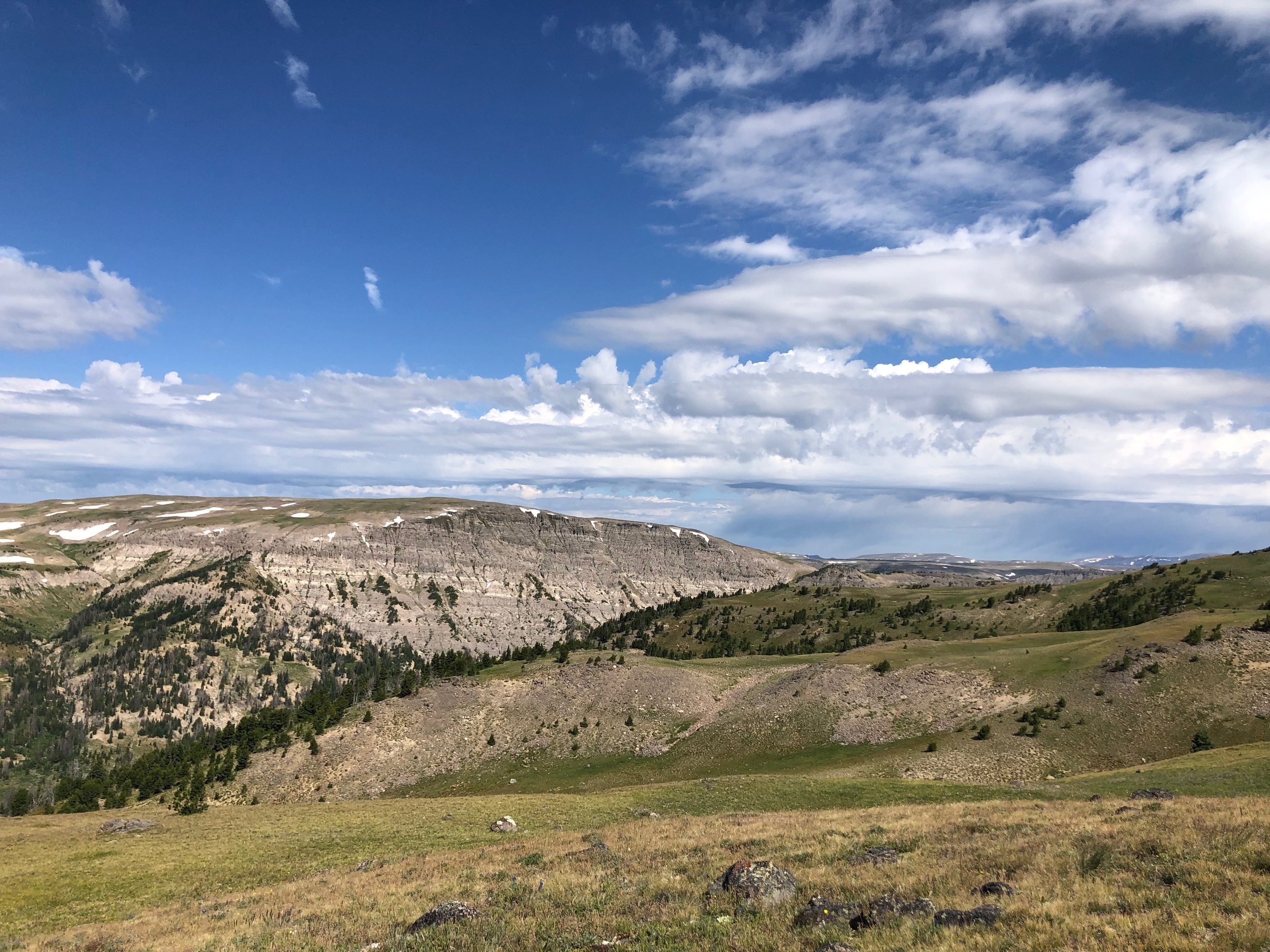
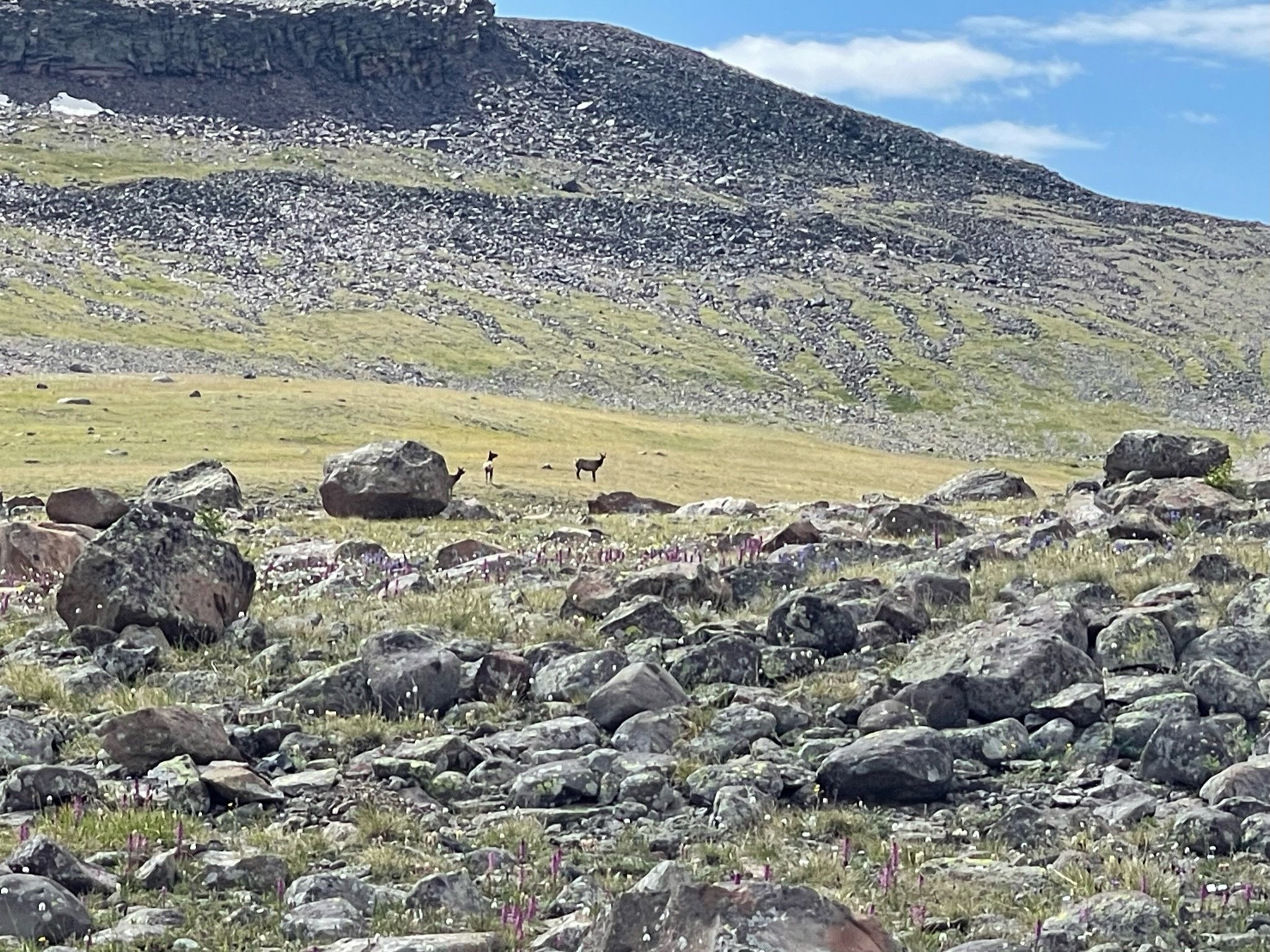
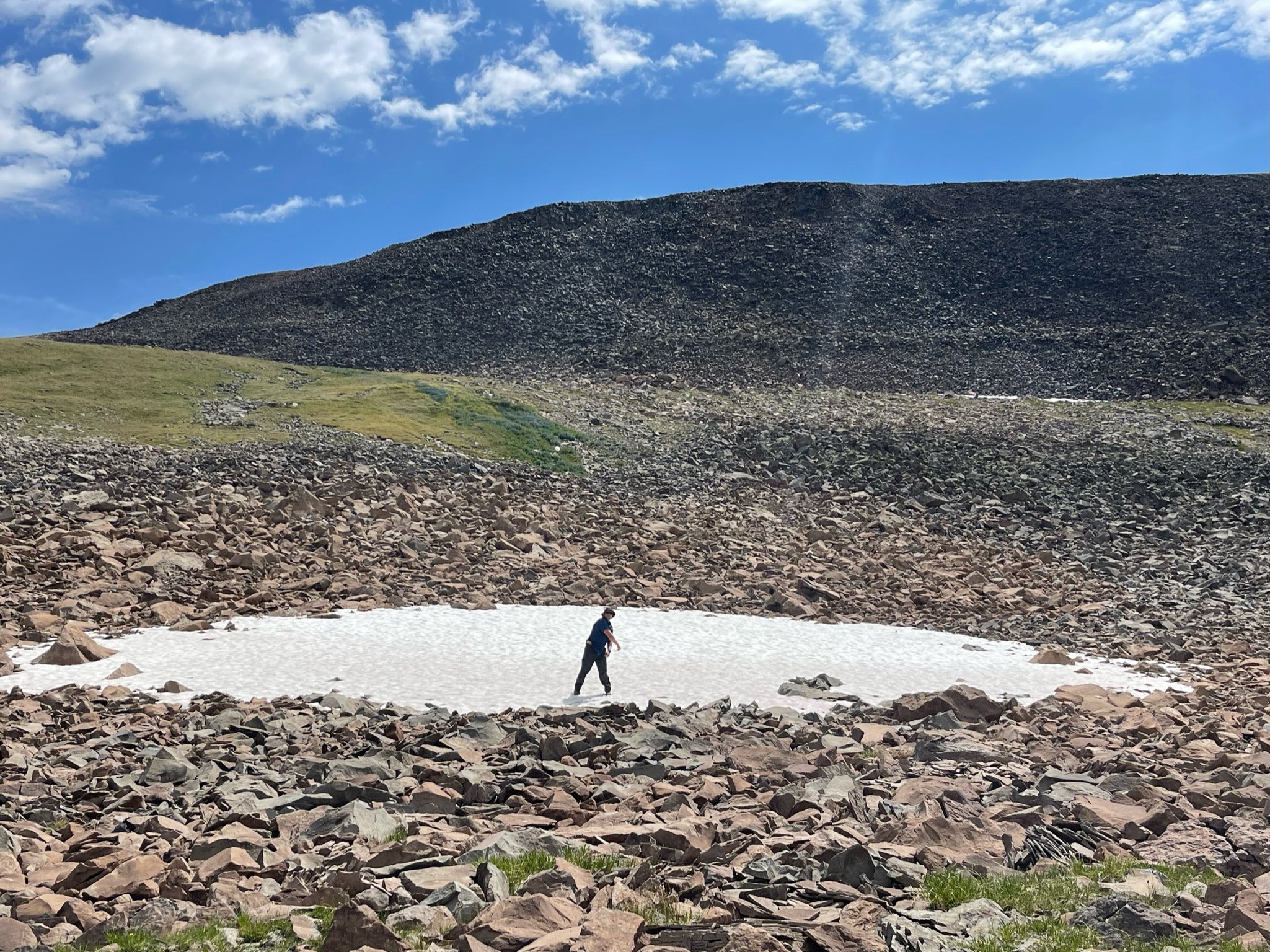
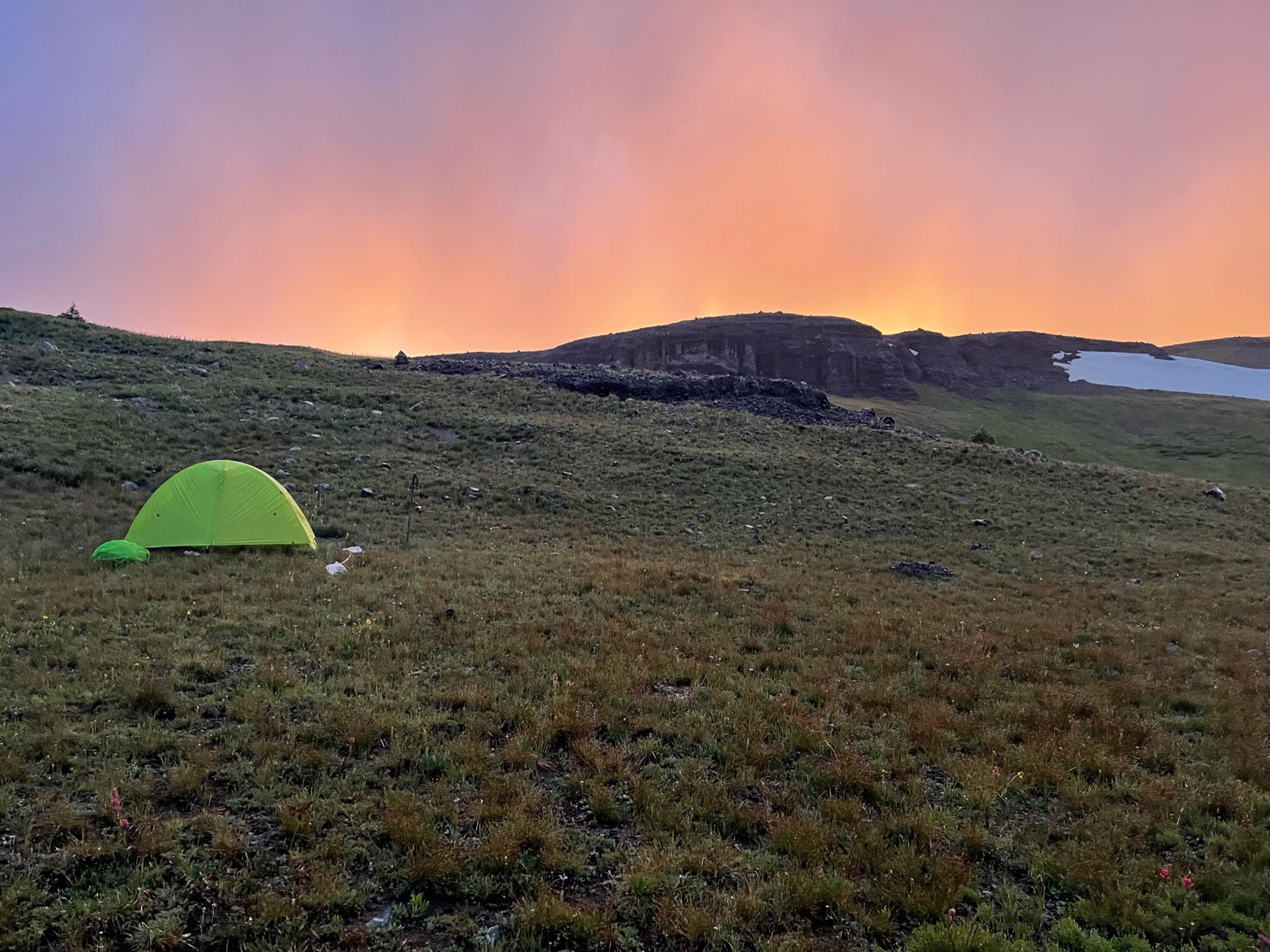
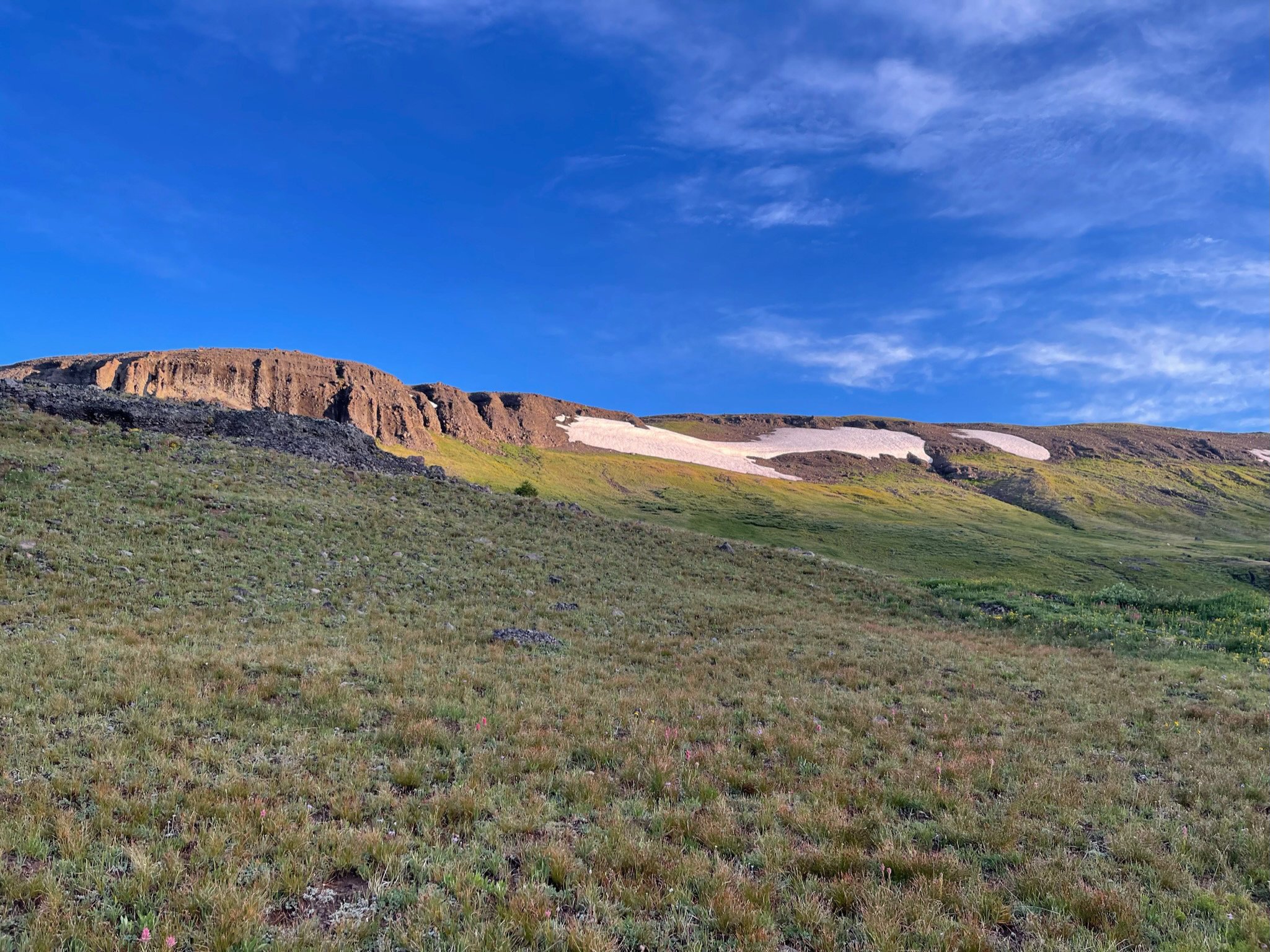
Day 4 – Ferry Lake
When the alarm went off at 5 am, my friend and I hit snooze and got an extra hour of sleep. At 6 am, we practiced our usual routine: pack up camp, eat breakfast, and hit the trail. The hike started with another steep climb up the slope of another plateau and quickly woke up our legs. Finally reaching the top, we were welcomed by a beautiful and expansive view of the backcountry: rolling hills and plateaus that reminded me of the links and dunes of Ireland. Green grass and boulders decorated the rolling hills we navigated. We crossed a creek and kept the high ground (Anakin!) to avoid unnecessary work.
In the distance, we saw Wall Mountain, Thoroughfare Mountain, and Younce Peak, which is considered the most remote peak in the lower 48 and rumored to have a lot of grizzly bear activity due to the thriving moth population that takes advantage of the micro-climate created by the mountain's shadow.
After hiking 5 miles, we reached the end of the plateau and had a snack. We decided to wait until camp to have lunch to avoid getting caught in the storms and discussed climbing Younce Peak, which would be an 8-mile detour and involve some substantial elevation gain. It would’ve been quite an achievement, but with frequent storm activity, we realized it wasn’t feasible. As we descended the plateau, we admired the wildflowers and saw the trail again for the first time in 2 days!
After crossing the river, we took another break and filled our water. We saw a party of horses and, feeling haggard, joked about asking them which month it was. As the party passed, they mentioned it was day 12 of 14 for them, and we were humbled. While we waited for the group to pass, we looked around the rocks and found some pieces of petrified wood. Fossilized, these wood pieces felt more like rock and were perfectly preserved by the glaciers that passed through millions of years ago. As the sun got hotter, we hiked 7 more miles to camp and passed waterfalls, more fields of wildflowers, and beautiful mountains. After another steep climb, we finally saw our destination, Ferry Lake.
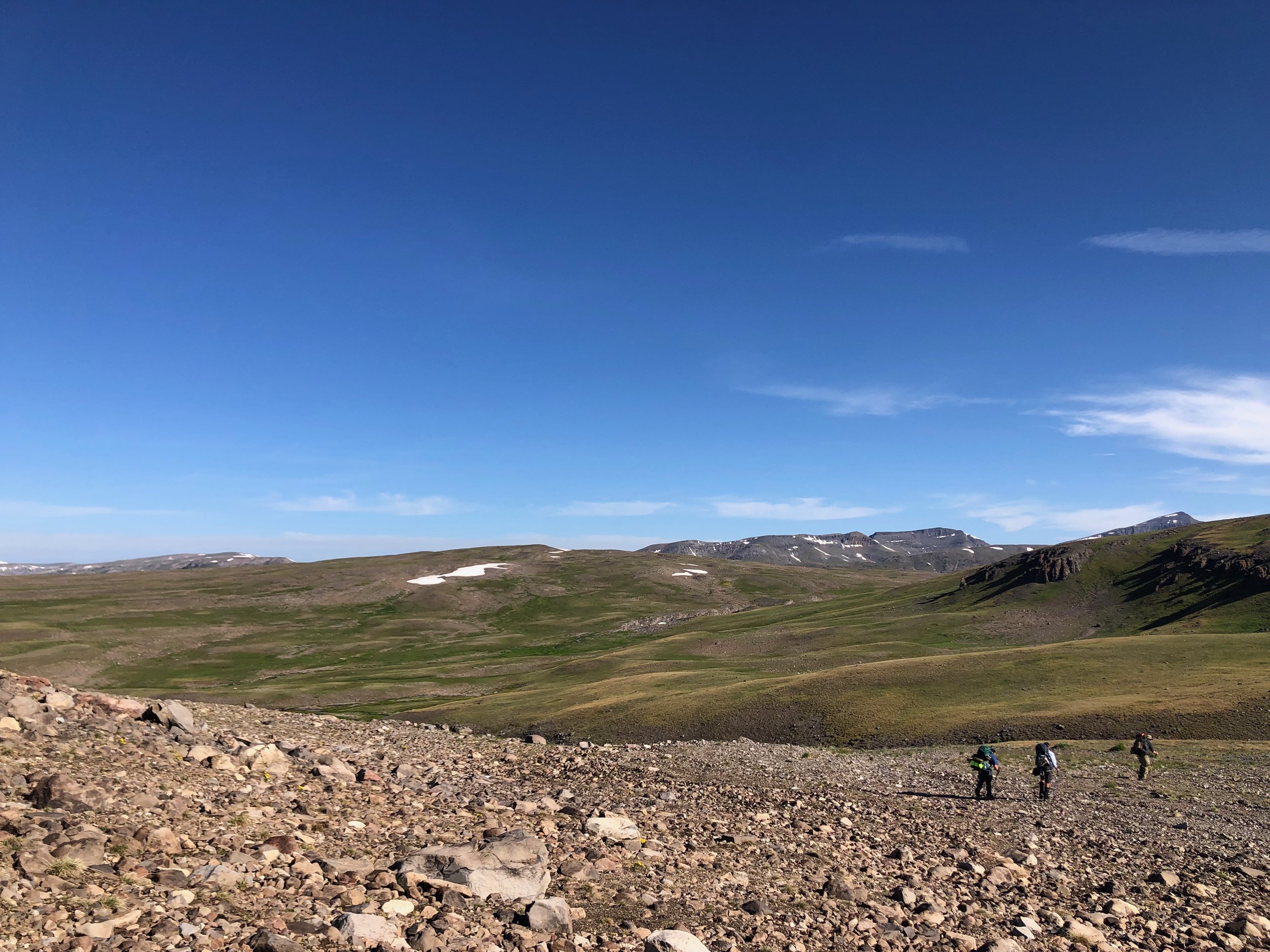
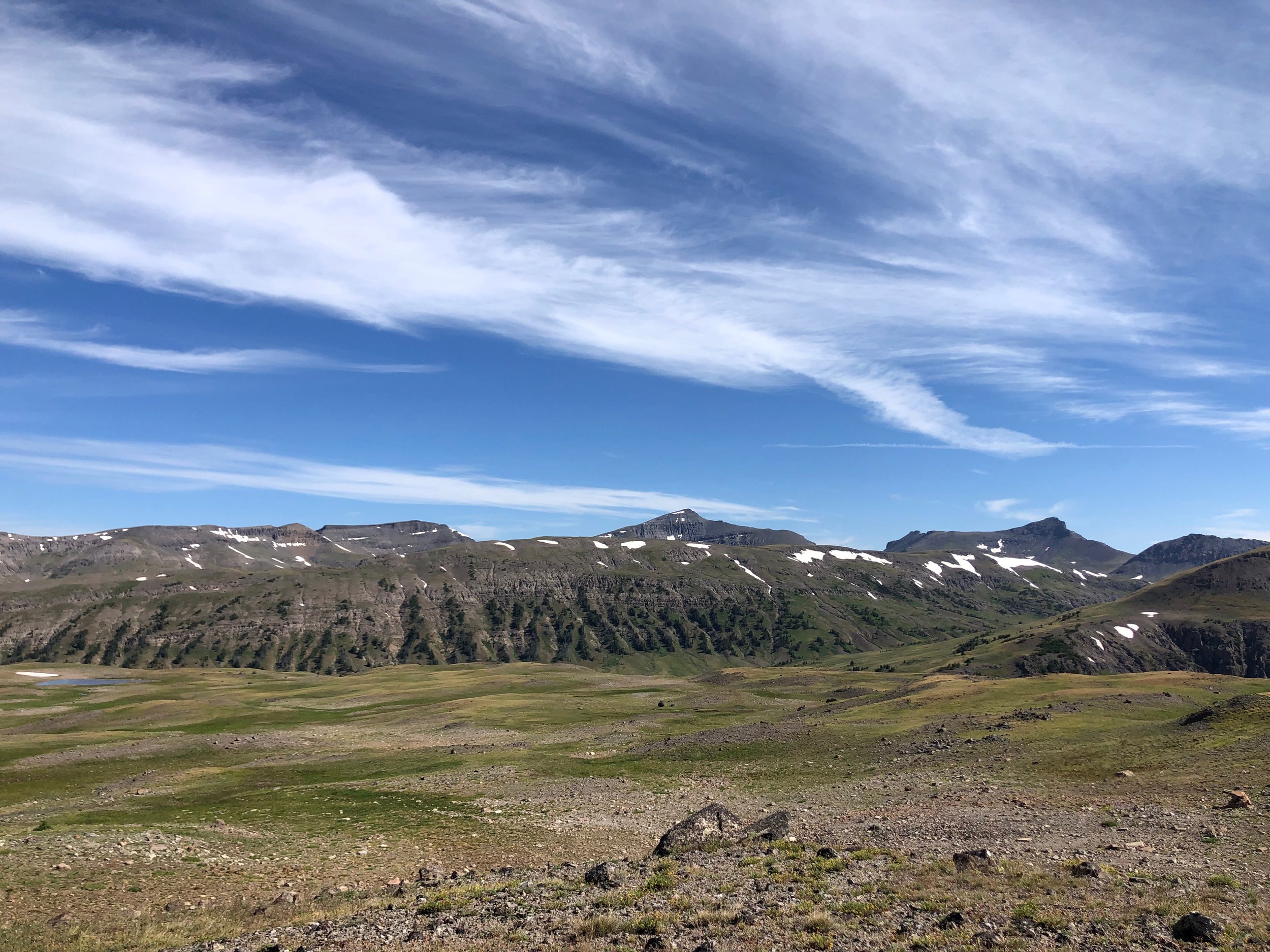
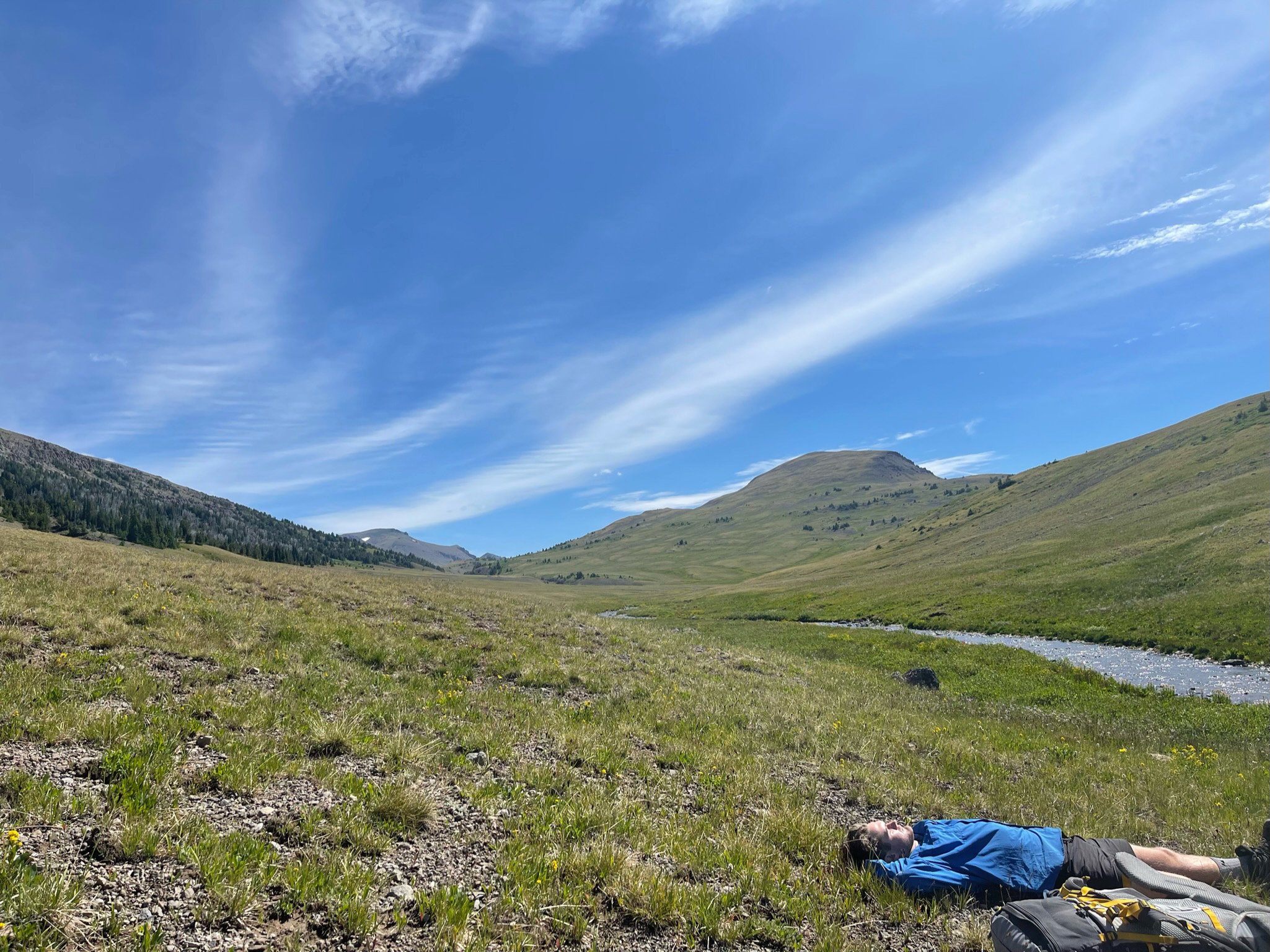
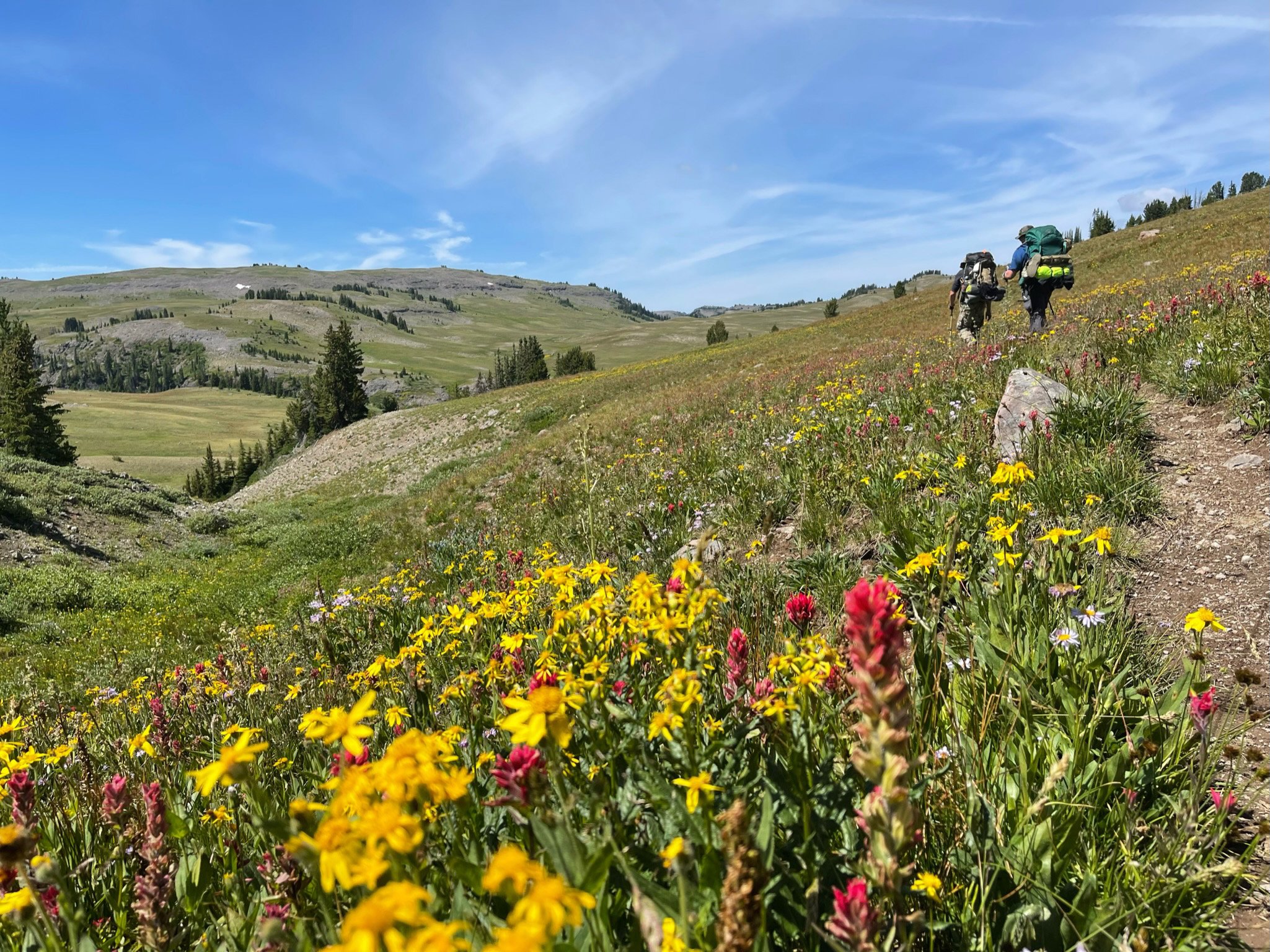

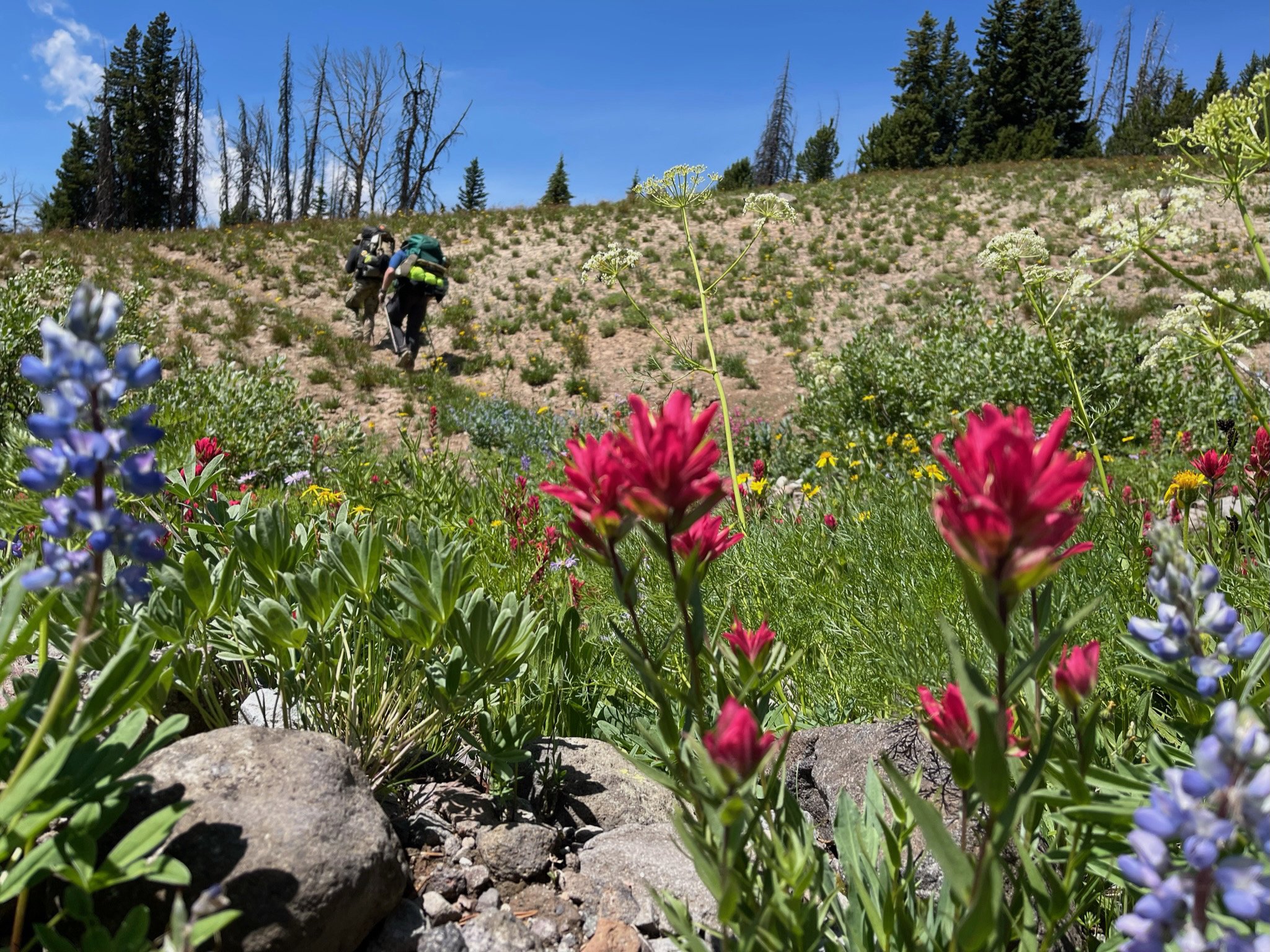
We went around the lake towards a grove of trees to have fuel for a fire later and found another outfitter’s camp. A perfect spot for scouting elk, the camp was perched on a cliff with room for horses, a view of an incredible waterfall, and two bear lockers to store our food. Arriving at 1:30 pm, we set up camp and talked about how glad we were that we woke up earlier and missed the storms we saw forming over the plateaus we had crossed a few hours earlier. I set up my hammock by the waterfall and washed off in the waterfall before eating. I swayed in my hammock and admired the oasis. I ate a tortilla with tuna and sun-dried tomatoes for lunch and then went swimming in the lake. By Ferry Lake, the bugs were worse than by the waterfall, but weren’t as bad as Perrian-Body Lake. We changed and made a fire, and my buddy and I went to the meadow near the lake while the others watched the fire.
The lake was vast, with giant hills on both sides. Harmless clouds rolled over the lake and fought like dragons as they whisped and crashed into each other. We stretched and laughed. I tried doing a headstand to see the lake upside down, but fell over and laughed some more. We regrouped with the others by the fire and discussed our accomplishments throughout the trip. As I smoked some pipe tobacco, I realized that few people would ever experience this wilderness and its beauty. Very few people want to carry 50-pound bags and trek 4 days into the unknown. When I was done, I went to my hammock and wrote a poem while listening to the waterfall.
By the fire, I relaxed and ate my favorite Mountain House Meal: beef stroganoff. As the storms water the plateaus, we realized why they were so green. The setting sun cast a golden hue over the hills, and the valley grew darker. We hung by the fire and talked about life. Brandon’s friends went to bed, but he and I stayed up, hoping to see the stars. Unfortunately, the warm front covered the sky with clouds, and we went to bed. That campsite and lake were truly something from a Ferry(lake)tale.

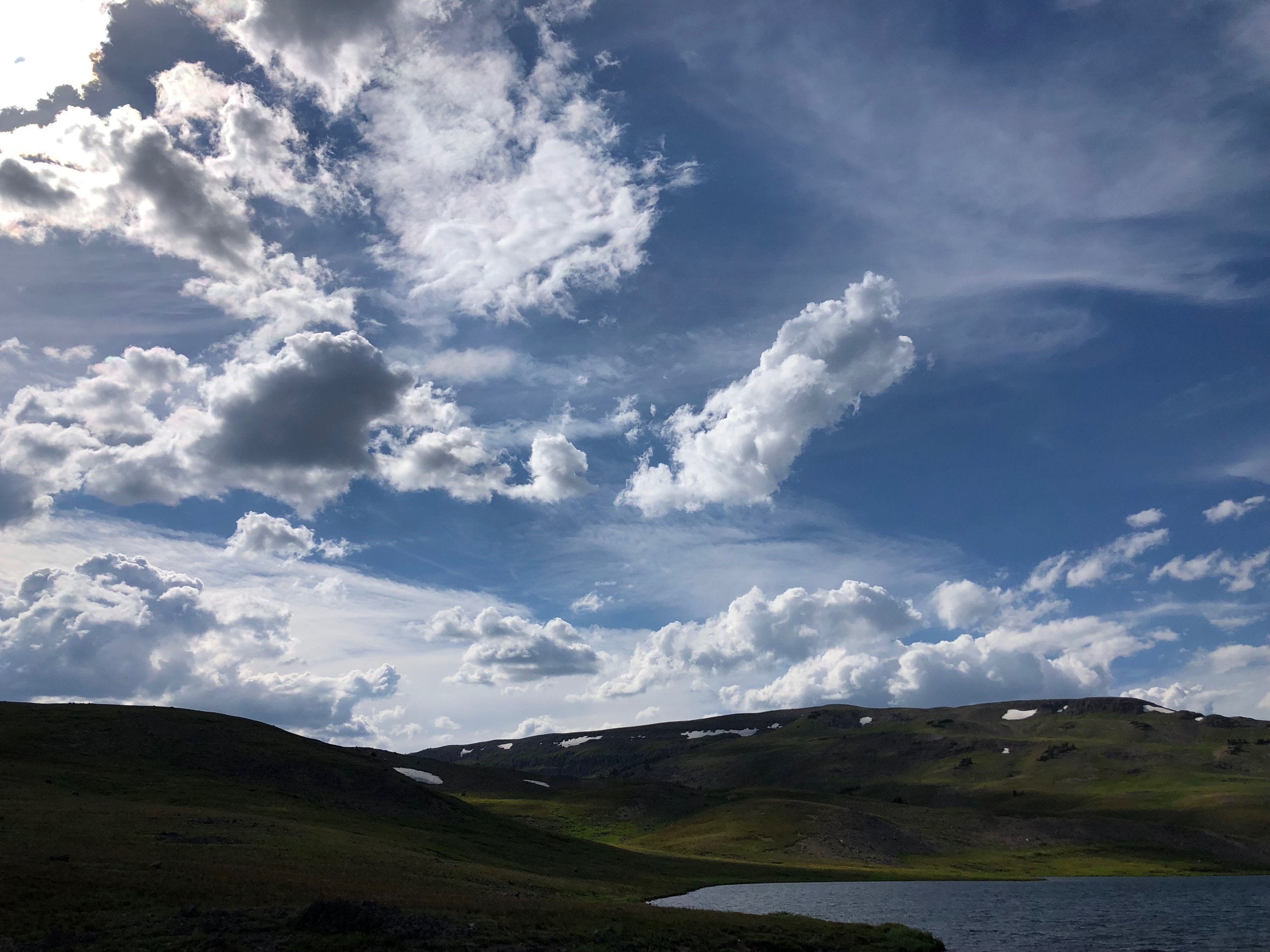

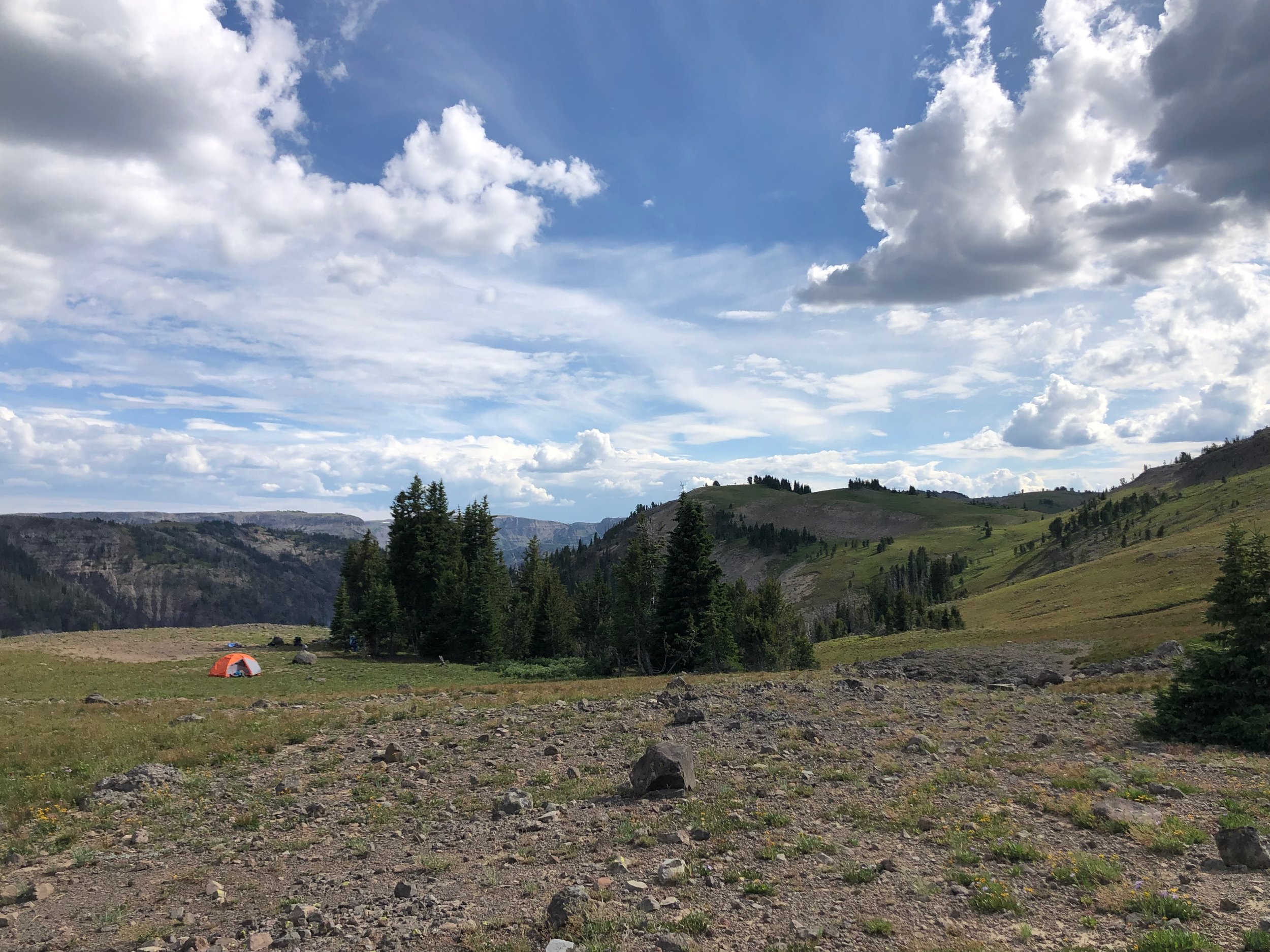
Day 5 – Pentegraft Peak
I set an alarm for 6 am, but my ringer wasn’t loud enough, and we slept until 7 am. A pattern was forming. We did our usual routine and had a small fire. Leaving camp around 7:30 am, we began our descent. The goal for the day was to hike 10 miles to a meadow along a river near the base of Pentegraft Peak (elevation: ~10k ft). Finally closing the loop, we joked that we just had a 3-day hike back to the car. As the warm front from yesterday drizzled on us, we put our tarps over our bags. After the hot weather yesterday, the rain felt good. We continued our descent and entered prime mushroom territory characterized by moist, cool conditions and tons of coniferous trees on a sloping hillside.
As we hiked the switchbacks, I went in the back to go slower and keep an eye out for fruiting bodies. I saw a hard purple polypore with a white underside, ID unknown. I also started to see a wide variety of Agaricus mushrooms. I saw a few young white Agaricus mushrooms (possibly Destroying Angel). As we hiked lower, I saw a few orange/yellow fly agarics, one of my favorite mushrooms. I like this mushroom because it was one of the first ones I found and identified on my first backpacking trip after moving to the PNW. Although the likelihood was slim, I hoped to see morels as we passed a torched area. I saw a velvety red polypore (possibly beef-steak fungus) on a downed log. The burn area also had a bustling fireweed population, a pinkish-purple flower that can be harvested and used to make teas, jellies, and other tasty treats. We had a snack (a meat stick and a Cliff bar) around 11 am and saw the Pentagraft Meadows in the distance.
Once we made it to Pentagraft Meadows, we kept an eye out for bear activity due to the numerous field strawberries, blueberry bushes, and other plants that bears enjoyed. Then, we crossed a cold river and started hiking up again. With substantial blowdown, we had to navigate fallen trees and blocked trails. My buddy spotted a Bolete with an orange/brown top, white pores, and a striped white stem, thinking it was a king Bolete, I collected a sample and noticed it had bruised blue – not a good sign for the eligibility of edibility. When foraging on such a long trip, I tend not to risk eating anything poisonous and often collect samples to eat back home after identifying the specimen with 100% certainty.
Near the base of Pentegraft Peak, we reached our campsite around 2:30 pm and crossed a rather sketchy, long log over the river. Still drizzling, we set up the tarp. While exploring the meadows, I found some more mushrooms, a patch of Agaricus Silvaticus (a brown/orange-ish agaric mushroom with brown gills, apparently edible), and some small puffball mushrooms. Also scattered about the meadow were more field strawberries. This meadow was perfect for grizzly bears.
As we dried off by the fire, an outfitters’ group passed by on horses and told us that they were camped upriver. They informed us that they had to kill one of their horses a few days ago and put it in the river after cutting it up. They warned us that predators might be by later in the night, attracted by the scent of the dead horse. This meadow was perfect for grizzly bears.
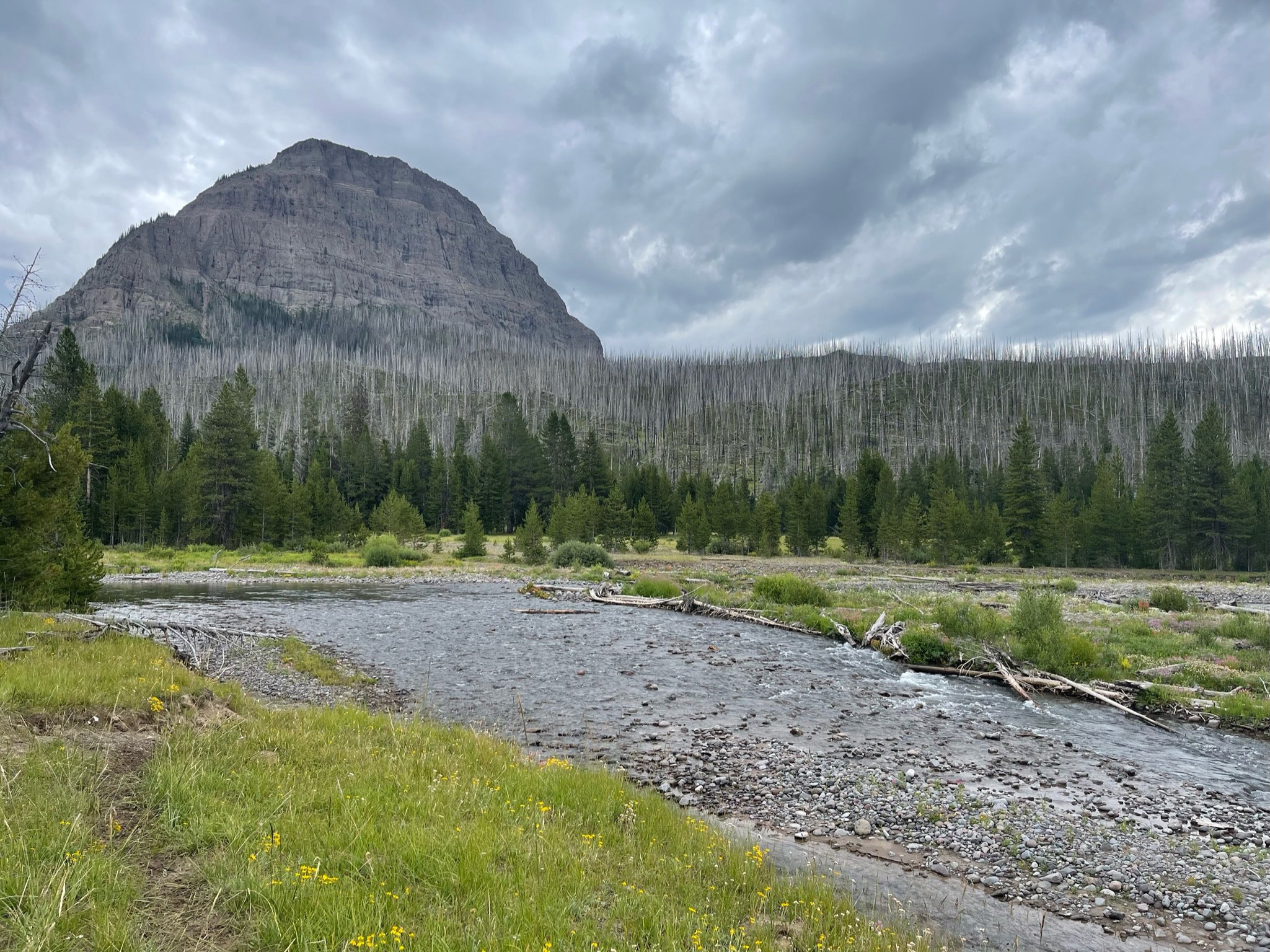
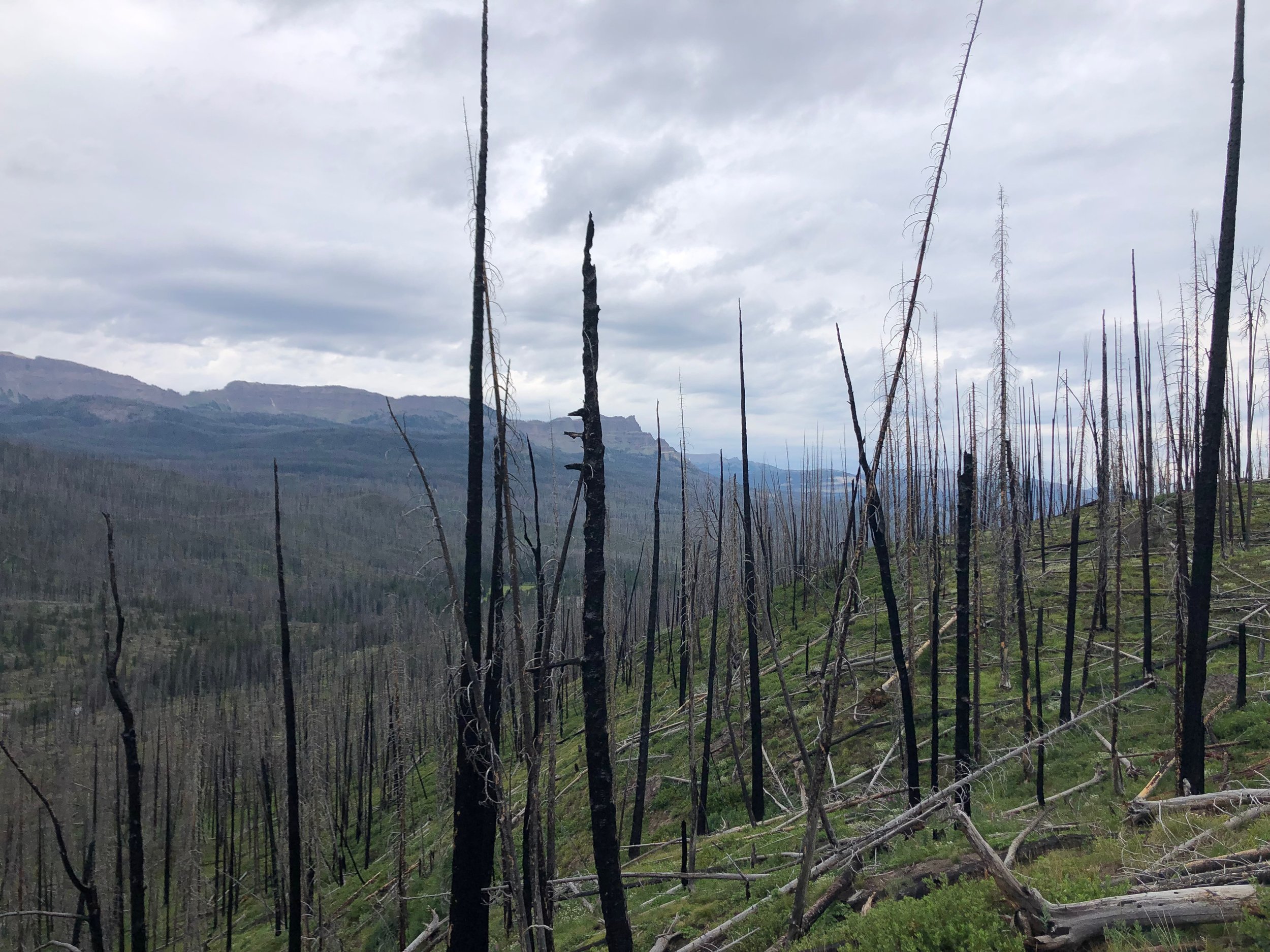
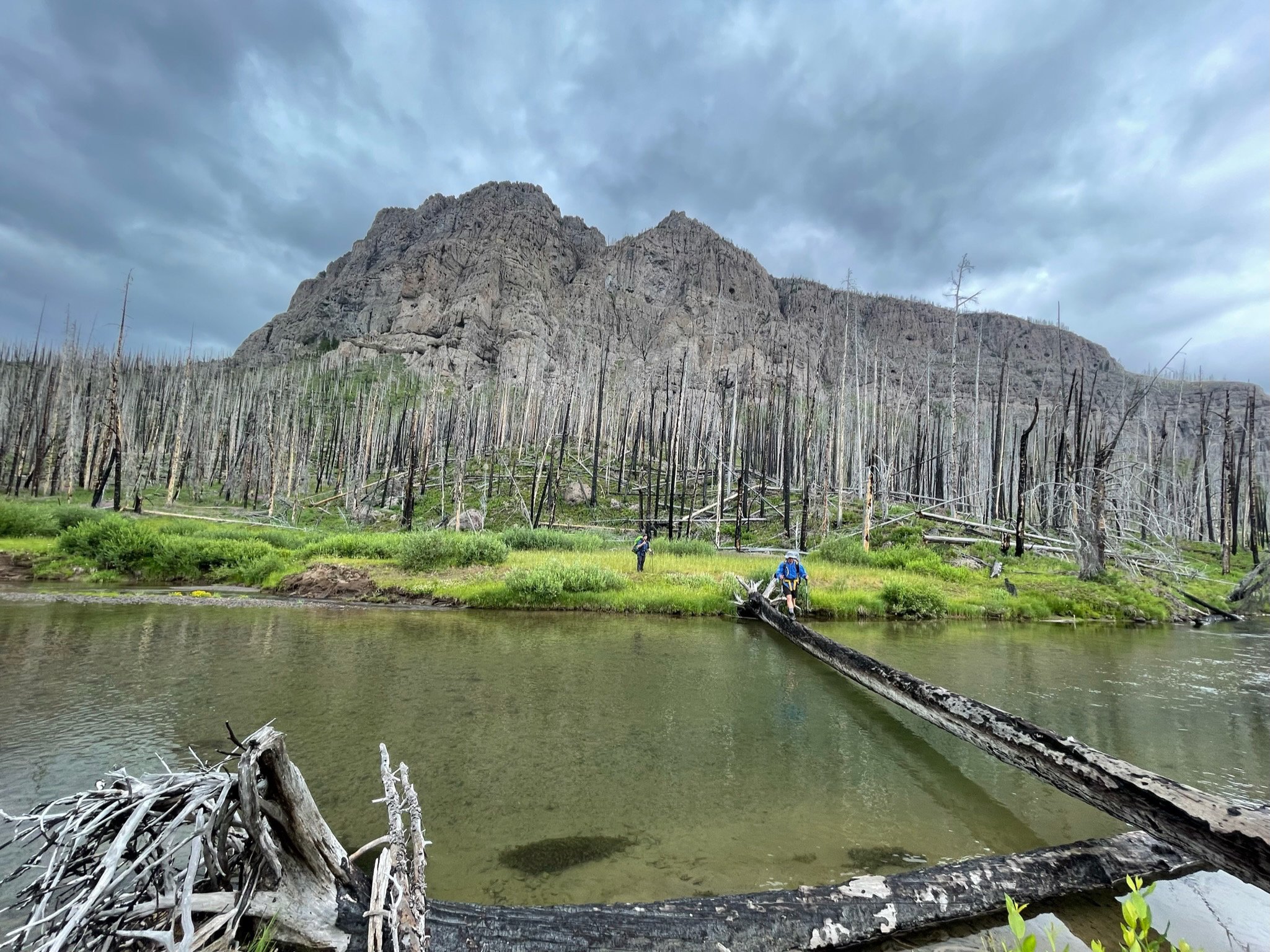
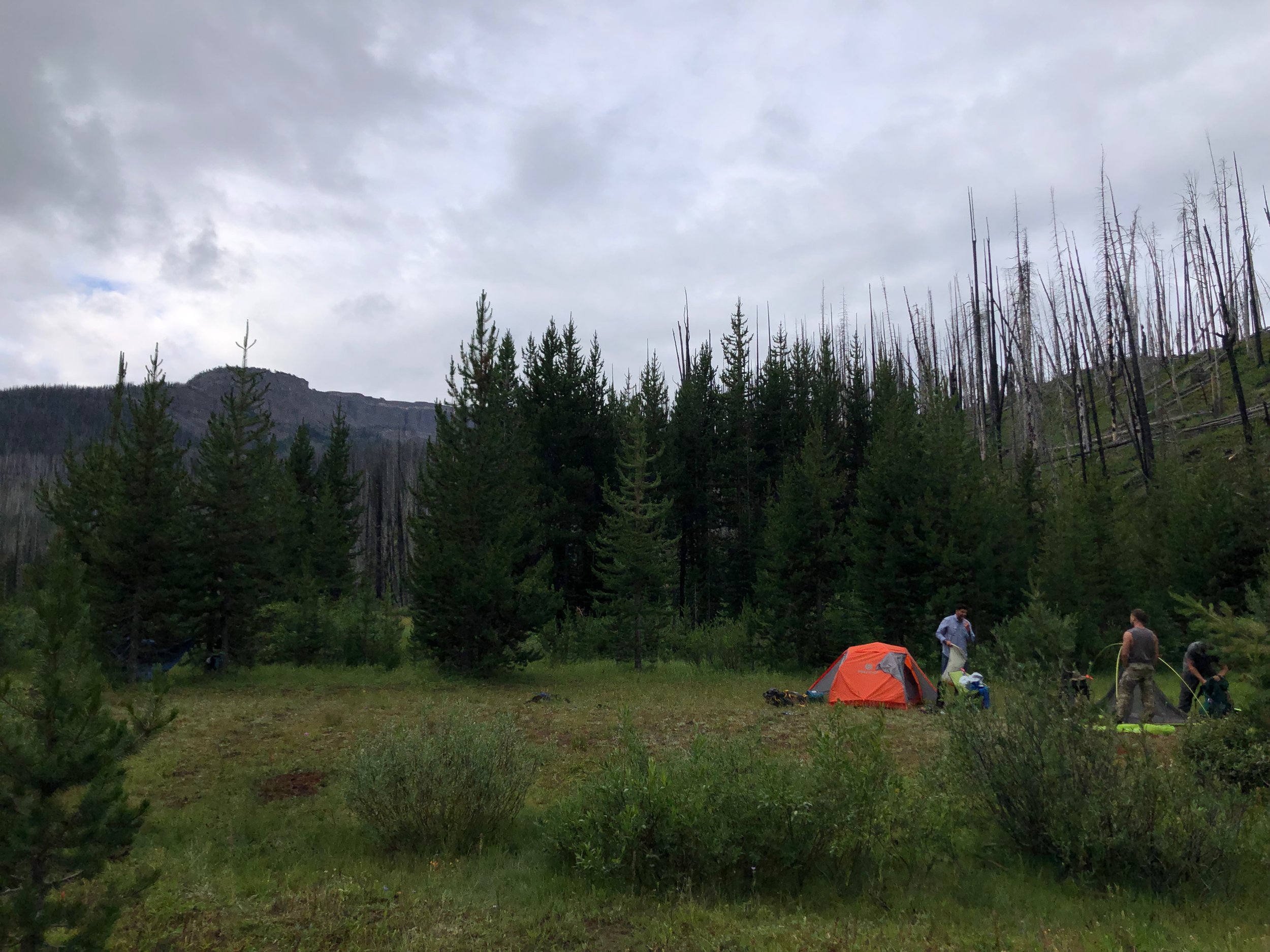
Soaked through my cheap rain jacket, I was cold, wet, and tired. After lunch, I napped while the others hung by the fire. I was out of caffeinated liquid IVs and was extremely groggy and slept for about 2 hours. When I woke up, the rain had lightened up, and I joined my friends again. We hung out and gathered wood to keep the fire going. We even jumped in the freezing river to clean up – nature’s ice bath. We changed, warmed up by the fire, and watched the vertical walls of Pentagraft Peak grow darker as the night settled in. We ate dinner and went to bed rather early, around 9 pm. On his Garmin InReach, Brandon got a flash flood warning for the next two days. Instead of prolonging our misery and risking our safety, we decided to hike the final 14 miles tomorrow instead of splitting it up over 2 days. As I tried to sleep, I heard a large animal in camp and grabbed my bear spray tightly. I mistook the wind blowing across the rainfly for an animal sniffing our tent. Eventually, I heard the animal cross the river away from us, and I fell asleep
Day 6 – The Hike Out
We woke up to a wet, cold drizzle and all agreed to hike the 14 miles out instead of camping in the rain. We left around 8 am and started our death march. Again, we crossed burnt forests and talked little as we sludged through mud and elevation. After about 5 miles, we snacked and kept going. As it rained harder, we hiked another 5 miles past lakes and mosquitoes. We stopped by a river on the side of a mountain, ate lunch, and filled up on water. The hike was still beautiful, but harder to enjoy considering the conditions. We descended into the valley where we had camped on our first night and started our climb. My legs were cooked, and I got sharp pains in my left hamstring. Constantly slipping on mud, my patience wore thin as I trudged up the hill.
We finally reached the top and had 2 more lakes to pass until we were back at the car. We passed Rainbow Lake and reached a small creek where we saw a bear in the distance. At first, we thought it was a black bear due to its coat being made darker by the rain but realized he had a hump as he searched the meadow for berries. Unfortunately for us, the bear was 50 yards away from our trail. As we made noise and yelled, “HEY BEAR,” it moved away momentarily. Then, realizing it was an apex predator, it returned to its original spot. Exhausted, we decided to bushwhack to the far right of the bear and the trail and got our bear spray ready. After getting well past the bear, we had 2 more miles and hiked on through the mud and rain. Around 4:30 pm, we finally reached the trail and saw the horses of Brook’s Lodge being let out to graze.
It felt like a circular and fitting moment: while we left the Teton Wilderness, haggard and disheveled, these beautiful animals returned to it. Soaked, we all piled into the car and headed to Jackson Hole to celebrate completing the hike in the comfort of civilization.

